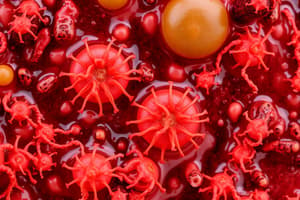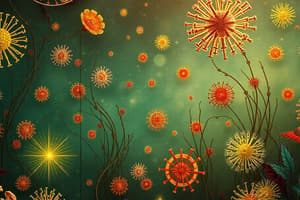Podcast
Questions and Answers
What characteristic of Pseudomonas aeruginosa contributes to its status as a nosocomial pathogen?
What characteristic of Pseudomonas aeruginosa contributes to its status as a nosocomial pathogen?
- Its rapid reproduction in the human gastrointestinal tract
- Its capability to grow in aqueous solutions (correct)
- Its preference for dry environments
- Its ability to form spores
Which clinical syndrome is NOT associated with Pseudomonas aeruginosa?
Which clinical syndrome is NOT associated with Pseudomonas aeruginosa?
- Chronic pulmonary infection in cystic fibrosis
- Ecthyma gangrenosum from bacteraemia
- Gastroenteritis in healthy individuals (correct)
- Colonization of burns followed by septicaemia
What is a common environment where Stenotrophomonas maltophilia is found?
What is a common environment where Stenotrophomonas maltophilia is found?
- Moist environments (correct)
- Cold storage facilities
- Coastal regions
- Desert areas
Immunocompromised patients in ICUs are particularly at risk from which environmental pathogens?
Immunocompromised patients in ICUs are particularly at risk from which environmental pathogens?
What is a key factor that increases the risk of infection from Acinetobacter spp. in hospitalized patients?
What is a key factor that increases the risk of infection from Acinetobacter spp. in hospitalized patients?
Flashcards
Environmental Pathogens
Environmental Pathogens
Microorganisms that spend a significant part of their life cycle outside of human hosts, but can cause disease when introduced to humans.
Pseudomonas aeruginosa
Pseudomonas aeruginosa
A type of bacteria commonly found in moist environments like sinks, drains, and hospitals. It is known for its ability to cause opportunistic infections, particularly in people with weak immune systems.
Stenotrophomonas maltophilia
Stenotrophomonas maltophilia
A common environmental pathogen associated with moist environments. It is known for its resistance to various antibiotics, making it a challenging infection to treat.
Acinetobacter spp
Acinetobacter spp
Signup and view all the flashcards
Legionnaires' disease
Legionnaires' disease
Signup and view all the flashcards
Study Notes
Environmental Pathogens
- Environmental pathogens are microorganisms that live outside human hosts but can cause disease when introduced.
Pseudomonas aeruginosa
- Description: Common in moist environments like sinks, drains, and contaminated hospital water supplies. Rarely found in healthy individuals.
- Clinical Syndromes:
- Chronic lung infections in cystic fibrosis patients.
- Septicemia (blood poisoning), with high mortality risk, especially for those with low white blood cell counts.
- Colonization of burns, leading to sepsis.
- Ecthyma gangrenosum: skin damage from bloodstream infections.
- Reasons for being a nosocomial pathogen (hospital-acquired):
- Grows well in aqueous solutions (e.g., IV fluids).
- Resistant to disinfectants.
- Compromised patients in hospitals are susceptible.
Stenotrophomonas maltophilia and Acinetobacter spp.
- Location: Found in moist environments.
- Resistance: Resistant to many antibiotics.
- Risk Factors:
- Colonize immunocompromised patients (e.g., in intensive care units).
- Patients with medical devices (e.g., breathing machines, IV catheters, implanted devices, urinary catheters, multiple cannulas, intubation).
- Patients with wounds from surgery or burns.
Studying That Suits You
Use AI to generate personalized quizzes and flashcards to suit your learning preferences.




